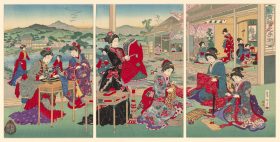When we think of immersive artworks, we expect a physical connection (or a bodily response at least), between the viewer and the object. That expectation has grown as audiences have become more conditioned and familiar with viewing artworks this way, and also more critical of that very ‘experience’.
Ouroboros – Lindy Lee’s sculpture commission unveiled this week at the National Gallery of Australia (NGA) – is in many ways an anomaly to this conditioning.
Unlike many immersive experiences reliant on video projections in a blackbox environment, Ouroboros sits alongside a busy Canberra boulevard. It has no ticketed entry or viewing hours, and it is said to have a lifespan of 500 years.
Part of that lifespan is the result of the surface of Lee’s sculpture – which is also what gives it that spark for viewers. Polished to an extremely high shine, Ouroboros seeming absorbs its surroundings – including the image of its viewers – and reflects them to the world.
This is the real success of Lee’s sculpture – it gets that passive animation right. Sitting in a shallow reflective pool of water (that is 240 square metres, so generous in scale), the sculpture seemingly shimmers – and in that conceptually links so beautifully to Lee’s aims.
She has said, “I want you to feel something – a deep connection to something that is much larger than any of us as individuals.” And viewers do. They walk over the pool of water along a pathway that levitates them, and delivers them into the belly of the sculpture. It arcs around them, inviting them to pause.
And, by night, all that energy soaked up by the day, is reflected back at night via 45,000 illuminated perforations, which offer a delicate, magical quality.
Taking the form of a snake that circles back on itself, in an endless cycle of life and renewal, the sculpture has been gendered as female by Lee – not that this really matters to a viewing audience.
What is more important is the scale of this work. A lot of public sculpture get the scale wrong – it is either too big or too small. Ouroboros sits beautifully within the landscape, and it has a human scale. We are not overwhelmed (or underwhelmed) by our encounter with Ouroboros. And, sitting within proximity of James Turrell’s Within without skyspace, it deepens that destination experience of the Gallery’s sculpture gardens.
One of the goals of the commission was to create a beacon that identifies the National Gallery of Australia. As Federal Minister for the Arts, Tony Burke said at Ouroboros’ unveiling, “People [previously would] drive past not knowing they are driving past a gallery… and will now always know, at the moment you glance in this direction, that you are at the National Gallery of Australia.”
Burke continued: “The invitation is there to walk and be within the art itself… This will capture people, and it will have moods, as the sun moves, and on different days.” From this perspective, Ouroboros is a huge success.
The unveiling of Ouroboros has been partnered with a small self-titled exhibition of Lee’s work in the Gallery. Central to the space is a grove of blackened trees titled Charred forest, another new commission. It comprises camphor laurel trees that have been treated using the Japanese preservation technique of Shou Sugi Ban, which blackens the logs, before being pierced with a scattering of conical holes revealing the natural colour of the timber underneath.

It directly links to the perforations of Ouroboros, and across the exhibition other works from scrolls to portraits – also perforated – speak to notions of existence, migration, transformation and hope.
The real highlight in the exhibition is a suite of paper scrolls tapping Lee’s Chinese ancestry through Taoism and Ch’an (Zen) Buddhism philosophies that see humanity and nature as inextricably linked. Titled Absolute fire (2023-2024), the paper has been subjected by Lee to “the will of nature, allowing rain, heat and light to impart patterns and textures on their surfaces,” explains the Gallery. They are finished with a red-hot soldering iron branding them and allowing them to breath. They are absolutely stunning. And, like Ouroboros, which gets the scale right, so too do these scrolls, in the way they pull you into their physicality.

The exhibition appropriately includes one of Lee’s bronze ‘splash’ calligraphic works – The unconditioned (2020), and a suite of portraits from the Gallery’s Collection.
An odd addition, however, and feeling a little askew to the philosophies that underlie Lee’s works, is the precious work, Abundance, a replica of Ouroboros on miniature scale created from 50 kilograms of pure ABC Bullion gold and currently valued at over $10 million. Funnily, for this writer it pales in comparison to the awe that ‘the real thing’ offers.
It was created as part of a partnership with the Pallion Group, along with a line of jewellery. We all recognise the role and need for sponsors, but this one just feels a little off-kilter embedded in the exhibition space, and so closely connected to Ouroboros in form.
Overall, however, these new works in tandem – inside and outside the Gallery – attest to the deep respect for Lindy Lee as an artist, and her contribution to Australian art. She taps universal themes and encourages us all to grow in the experience of her artworks.
Ouroboros is also a great lesson in embracing ambition in a generous and generative way.
Lindy Lee’s Ouroboros is permanently open and is free to view.
Lindy Lee (the exhibition)
National Gallery of Australia
25 October 2024 – 1 June 2025
Free.





